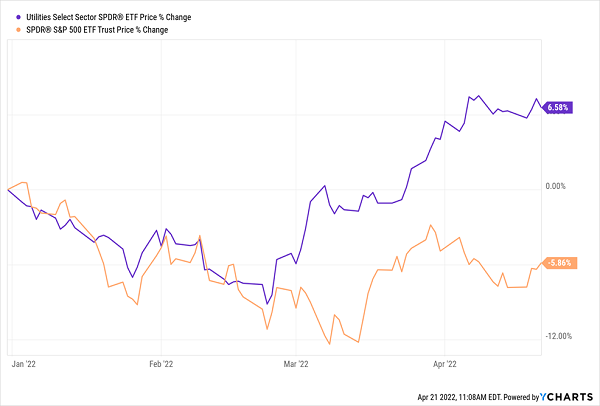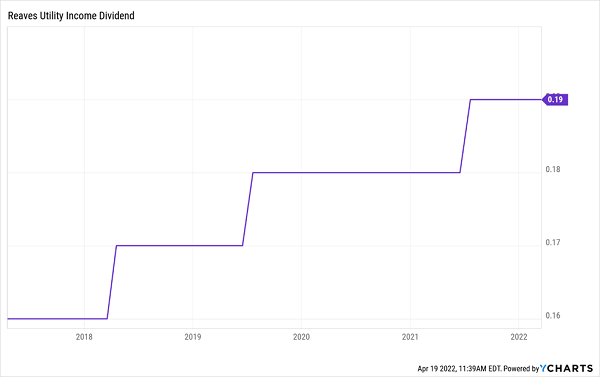If you’re looking for reasons to toss and turn at night, there seem to be plenty these days…
Ever-rising prices and ever-shrinking inventories of key goods, from energy commodities to microchips.
The first period of tighter monetary policy in the US in over two decades.
A bloodbath for some of the biggest names in tech, as evidenced by the latest tailspin for Netflix just a few days ago.
There’s an old saying that the definition of insanity is doing the same thing over and over, yet expecting different results. But many investors seem to be doing just that, fighting this difficult environment with the same old tech stocks like Netflix and the same old index funds that are bleeding red ink in 2022.
There are other places to put your money, however. Much better places. And I will show you where—by looking beyond the usual suspects.
Take the utility sector, for instance. This sector has proven to be a hidden gem and has outperformed nicely so far this year. The leading ETF in the space, the $15 billion Utilities Select Sector SPDR Fund (XLU), is up about 6.6% since Jan. 1, which is pretty impressive considering the S&P 500 has shed 5.9% over the same period as I write.

There’s one catch though: While utilities are indeed low risk investments, some of the biggest names in the sector still leave much to be desired when it comes to income potential. This top sector fund pays a meager 2.7% yield at present. And if you’re a stock-picker by nature, many individual names yield less—including XLU’s top component Next Era Energy (NEE) that pays you a paltry 2.1% yield.
So how can you split the difference here, finding an investment that offers outperformance and big-time dividends.
Keep reading and I’ll show you—via a great alternative utility play that can generate 3X the yield from this low-risk sector.
And best of all, if you act fast you can buy it for a discount and only wind up paying 98 cents on the dollar!
Closed-End Funds Are A MUST HAVE Investment Right Now
Don’t worry, I won’t play games or leave you hanging. The investments I’m getting at are closed-end funds, and my top pick is the Reaves Utility Income Fund (UTG).
In a moment, we’ll dig deeper into this CEF that puts other investments in the sector to shame. But it’s worth going through the big picture first, so you can understand why closed-end funds are an absolute necessity if you want to keep your retirement funds safe—and growing via dividends—regardless of the day-to-day gyrations on Wall Street.
We have plenty of research reports at Contrarian Outlook that identify closed-end funds that exemplify these benefits. But if you’re new to the asset class, here’s the short version of why CEFs are a must-own asset.
Closed-end funds are simple to understand: They operate in many of the exact same ways your favorite mutual funds or ETFs do. CEFs are transparent, and if you know where to look it’s easy to find what they hold, what their distribution cycle is and how experienced the managers are.
A little research can save you a bundle: A significant difference between mutual funds and ETFs, however, is that closed-end funds rarely create new shares. That’s where the “closed” portion of the name comes from. And this lack of flexibility means that unlike ETFs like XLU, closed-end funds occasionally trade at discounts to their underlying assets. Those discounts eventually resolve themselves over time… but clued-in investors can act fast to buy at bargain pricing.
A little leverage can deliver mammoth dividends: Perhaps the biggest difference of all, however, is that closed-end funds aren’t formulaic like the index funds out there. A good CEF has a skilled management team that knows how to look beyond the usual suspects to find outperformance. And it also knows how to responsibly use leverage to deliver outsized gains typical funds can’t match.
Now, plenty of investors prefer to stick with the old rules because they are comfortable.
They’ll settle for 2% dividends in a stock like NextEra.
They’ll freak out at the very notion of looking beyond the sacred cow of passive index funds, or pretend that a closed-end fund that uses leverage responsibly is no better than the loan sharks that caused the 2008 financial crisis.
But it’s precisely that kind of short-sighted approach that creates huge opportunities for savvy investors like us.
Snag 3x The Dividends, 3x As Often, In This Bargain CEF
Now on to the living proof that this strategy works, via my favorite utility-focused CEF—the Reaves Utility Income Fund.

Here’s why I like it so much:
- It yields 6.6%, more than three times utility stocks like NextEra.
- It pays monthly dividends, instead of quarterly.
- Those dividends are steadily rising every year—including increases over the pandemic-related volatility of 2020 and 2021.
- And it currently trades at a modest discount on underlying assets, meaning you’ll only pay 98 cents on the dollar.
What better option is there if you’re interested in utility income?
If you’re new to closed-end funds, or if you simply are looking for more recommendations that have the big-time yield and bargain pricing UTG offers, you shouldn’t stop with this pick. You should seriously consider what else is out there – including closed-end funds that trade for even deeper discounts, or offer even bigger yields.
As I said previously, there’s no shortage of research we have for you over at the Contrarian Income Report. We’ve identified plenty of other picks like this, offering monthly dividends that yield as much as 9.9% right now!
This isn’t a gimmick. It’s a proven strategy, built on deep research and a proven strategy that provides monthly income you can actually retire on.
So quit messing around with 2% utility stocks, or 3% ETFs.
Harness the power of high-yield CEFs that consistently generate 7%+ year-after-year and allow you to retire on dividends alone—without drawing down your hard-earned cash, and without taking on additional risk.
